
St. Vitus Cathedral (Katedrála Sv. Víta) is a Roman Catholic cathedral in Prague, which is an example of Gothic architecture, as well as the largest and most important church in the Czech Republic.
The full name of the cathedral: The Cathedral of Saints Vitus, Wenceslaus and Vojtech / Albrecht (Katedrála svatého Víta, Václava a Vojtěcha).
This majestic Gothic monument is the residence of the Archbishop of Prague and the spiritual symbol of the Czech state.
The cathedral has free and paid parts for visits, services and excursions are held, you can also visit the gallery of the South Tower of the Cathedral and admire the panoramic view of Prague (a visit to the observation deck is paid). The crypt of the cathedral, that is, the graves with the remains of Czech kings, is closed to the public. All possible visits to the cathedral, as well as the ascent to the observation tower, are described in detail at the end of this article.
The Cathedral of Saints Vitus, Wenceslas and Vojtech is located in the historical part of Prague, on the territory of Prazhsky Castle (Pražský hrad) and is its dominant. Entrance to the territory of Prague Castle is free.
Panoramic view of St. Vitus Cathedral from the observation deck Petrshinskaya Tower (Petřínská rozhledna)
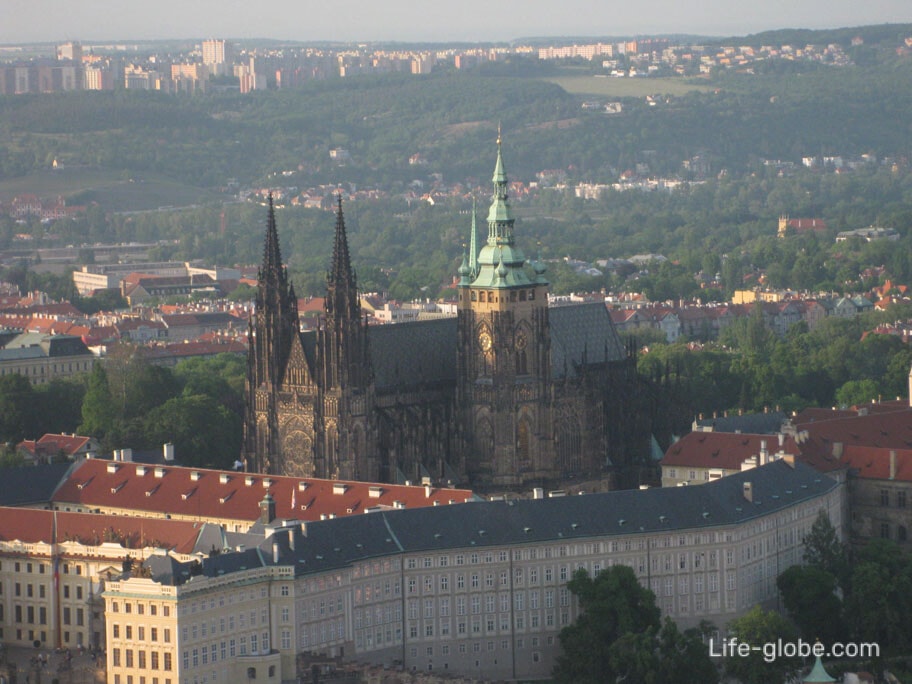
Until 1997, the cathedral was dedicated only to St. Vitus and is still more often called St. Vitus Cathedral. The current name of the cathedral is the Cathedral of Saints Vitus, Wenceslaus and Wojtek, the cathedral received on April 23, 1997 by decree of Cardinal Miroslav Vlka, who assigned the cathedral its original name.
The first church of St. Wenceslaus, which had the form of a rotunda in the early Romanesque style, was founded by Prince Wenceslaus I, who became the patron and heavenly protector of the people of Bohemia and the Czech lands.
The rotunda was replaced by a Romanesque basilica, the construction of which was begun in 1060 by Prince Spytikhnev II. The southern apse of the rotunda was included in the eastern transept of the new church, because it housed the tomb of St. Wenceslaus, who by that time had become the patron saint of the Czech princes. The basilica was also called the Spytikhnev Basilica; it was small in size and became the burial place of many Czech rulers and other members of the Przemyslovich and Luxembourg families.
After the establishment of the Archdiocese of Prague, approved by Pope Clement VI on May 5, 1344, the construction of the modern Gothic cathedral began. King Johann of Luxembourg laid the foundation stone of the new cathedral building on November 21, 1344. Johann's son Charles IV, King of Bohemia and future Holy Roman Emperor, conceived this new cathedral as a coronation church, a family crypt, a treasury of the most valuable relics of the kingdom and a place of pilgrimage for the patron saint Wenceslaus.
Many famous masters worked on the creation of the cathedral: the French architect Matthias of Arras, the German-Czech architect and sculptor Peter Parler, and then his sons Wenzel Parler and Johannes Parler, after they were replaced by Master Petrilk. The construction process stopped with the beginning of the Hussite war in the first half of the 15th century, during which paintings and sculptures were severely damaged by Hussite iconoclasm, and a fire in 1541 severely damaged the cathedral.
Since the second half of the 15th century, attempts have been made to complete the cathedral, but they were unsuccessful and brought only some elements in the Renaissance and Baroque styles.
The successful completion of the cathedral was started in 1861 and included the removal of Baroque elements, restoration and completion of the cathedral in the Gothic style. During the restoration, most of the design and elements developed by Peter Parler were used, which gave the cathedral a whole harmonious look. By the anniversary of St. Wenceslaus in 1929, St. Vitus Cathedral was finally completed, almost 600 years after its construction began.
Today, this monumental Gothic building is a wonderful decoration of Prague and an example of Gothic architecture.


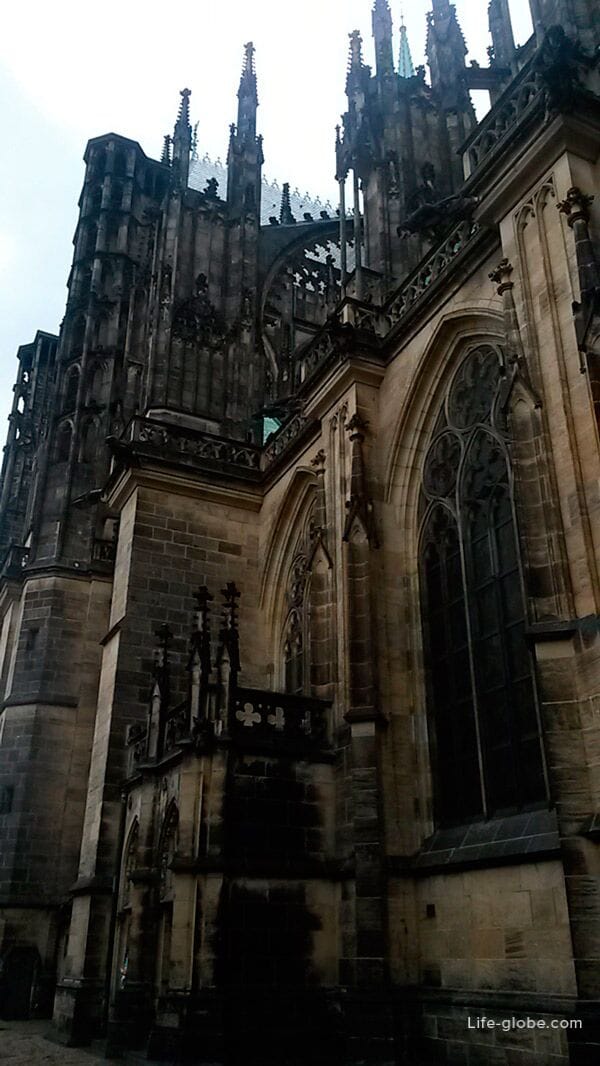
The main portal of St. Vitus Cathedral faces west. Here the pointed towers and the central pediment are directed to the sky.
The facade has three entrances with tympanums leading to the main nave of the cathedral. Above the portal there is a large rose window with a diameter of 10 meters, created from the cartons of František Kisely on the theme of the Creation of the world.
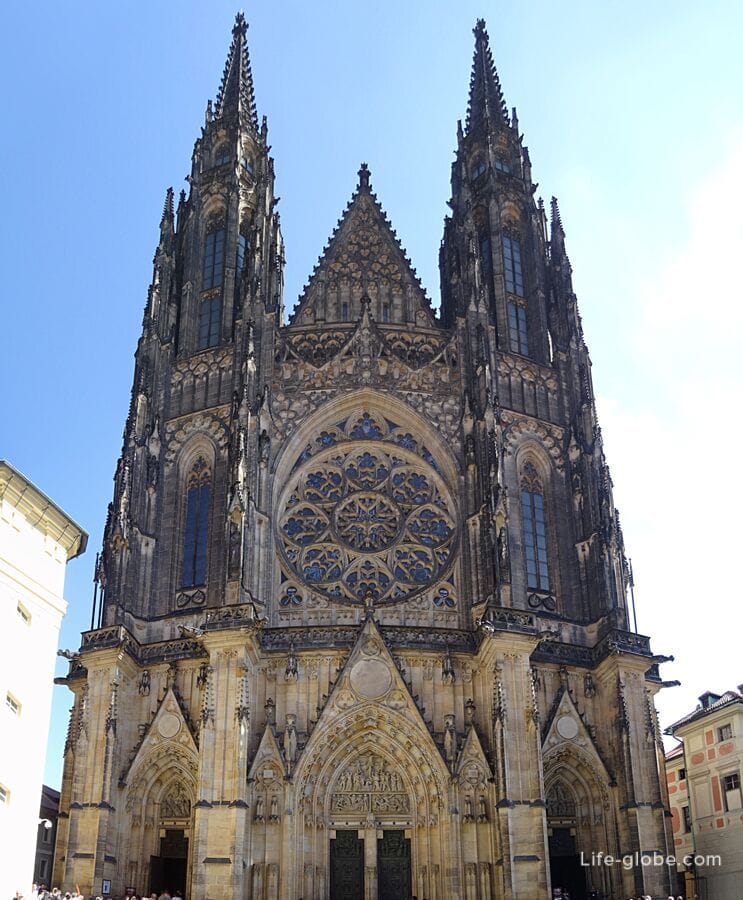

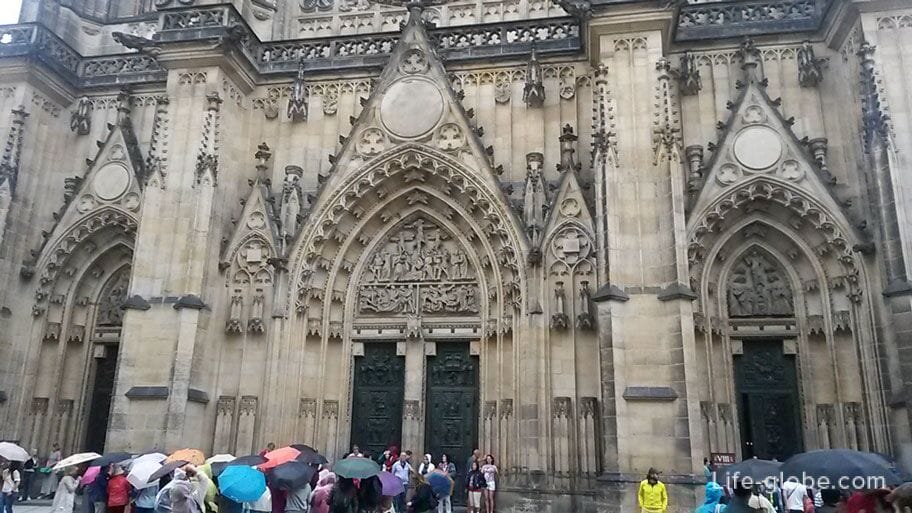
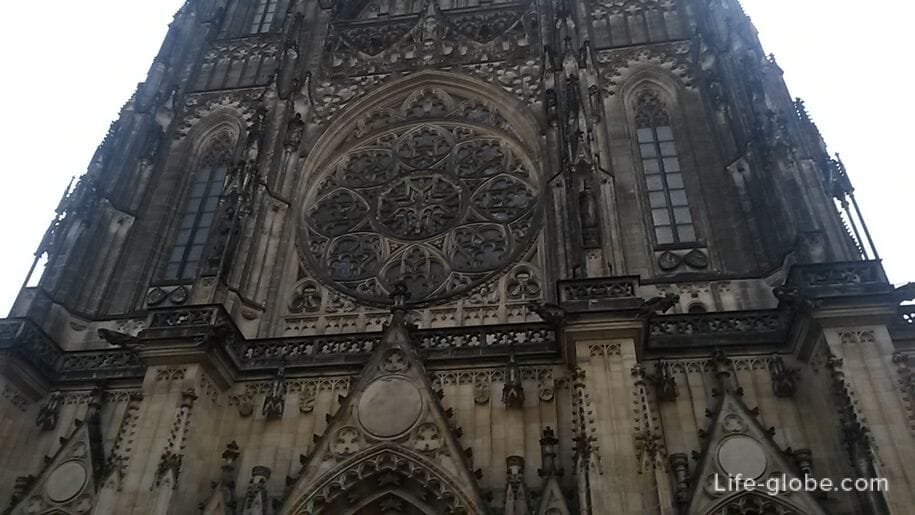
The south facade of the cathedral is the ceremonial entrance to the temple, where the entrance is called the Golden Gate (Zlatou bránou).
The arched entrances are decorated with a unique Gothic mosaic of the Italian type on the theme of the Last Judgment with the image of Charles IV and his wife Alzbeta Pomorzhanskaya, created in 1370-1371 by unknown mosaicists from about a million glass cubes and stones of more than 30 color shades.
At the entrance there is a bronze lattice decorated with calendar reliefs and zodiac signs, made by Yaroslav Goreyets in 1955.
On the same, southern side, rises the Great Southern Church Tower, which is also called the great bell tower and in the upper part of which there is a public viewing platform.

Photo of the Golden Gate of St. Vitus Cathedral

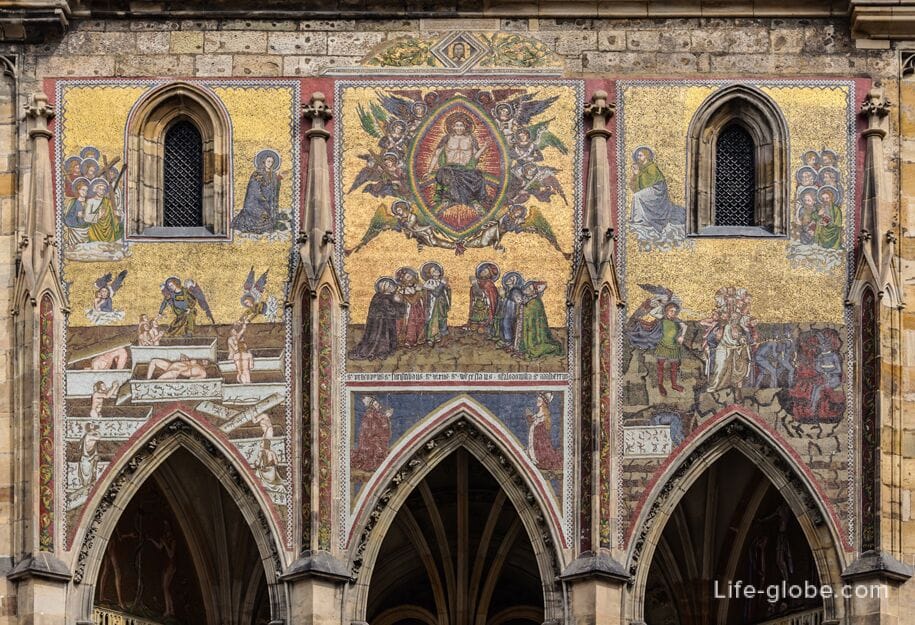
The eastern and northern facades of the cathedral are not so remarkable, but they are also bright in their Gothic design.

The interior of St. Vitus Cathedral amazes with a combination of grandeur and wealth, which at the same time are very subtly and harmoniously intertwined with a certain spatial simplicity and elegance.
Here, the high mesh Gothic vault of the main nave meets with exquisite stained glass windows, which, streaming from the penetrating light, pass into powerful arched openings, partially decorated with sculptures and carvings.
The side aisles are lower and are connected around nineteen chapels, old and new sacristy.
Among other things, the cathedral is decorated with paintings and semi-precious stones.

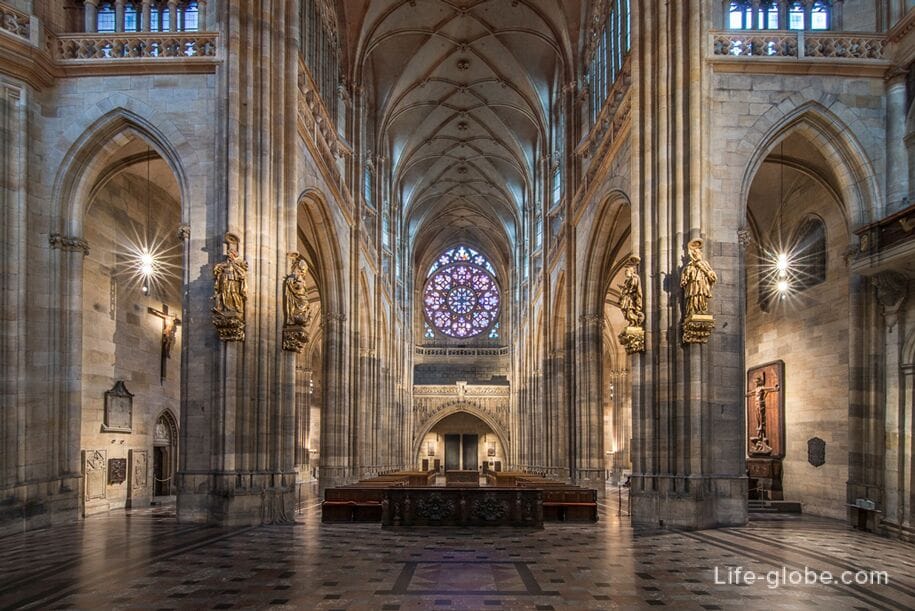
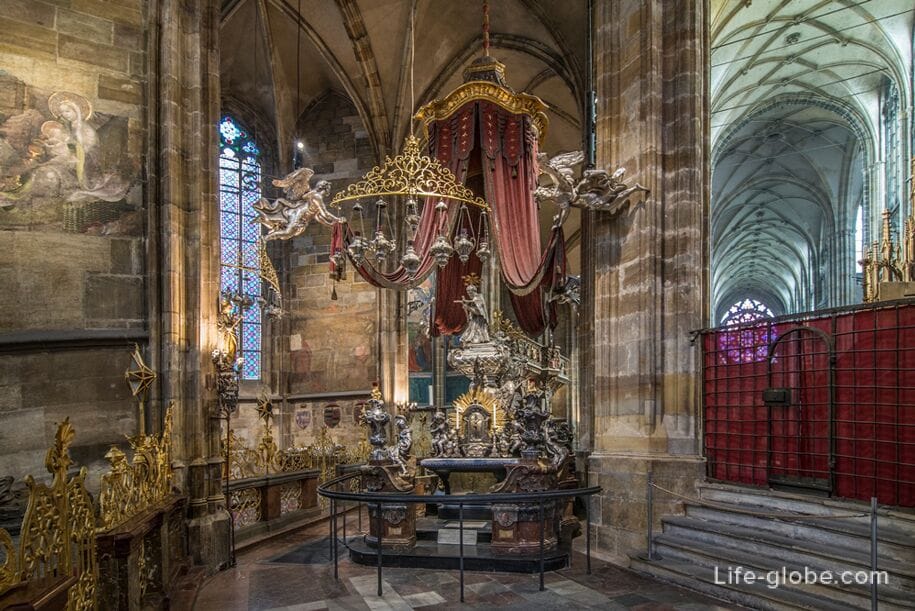
The space of the cathedral, at a height of about 14 meters, is divided in two by the Triforium, a balcony gallery that divides the cathedral into earthly and heavenly parts.
The Triforium became famous for a rare portrait gallery of 21 busts created by the Parlerge smelter in 1371-1385. There are busts of representatives of royal dynasties, archbishops and architects - creators of the cathedral, as well as more modern personalities who contributed to the completion of the cathedral.

The most prominent place in the cathedral is the Chapel of St. Wenceslas (Svatováclavská kaple) with a starry vault.
In the chapel there is a tomb with the relics of St. Wenceslaus.
The lower part of the chapel is decorated with semi-precious stones and paintings depicting the Passion of Christ, dating from the original decoration of the chapel 1372-1373. In the upper part of the walls there are paintings depicting scenes from the life of St. Wenceslaus. Above the altar is a Gothic statue of St. Wenceslaus, created by Jindřich Parler in 1373.
The door in the corner of the chapel leads to the stairs to the Crown Chamber (Korunní komory), where the coronation jewels are kept: the crown of St. Wenceslaus of 1346, the royal sceptre of the first half of the 16th century, the imperial apple of the mid-16th century, the crown case, the coronation cross, sword and textiles. The jewels have been a national cultural monument since 1962.
Who has the keys to the door leading to the crown jewels? There are seven keys: the President of the Republic, the Prime Minister, the Archbishop of Prague, the Speaker of the Chamber of Deputies, the President of the Senate, the Metropolitan Chapter of St. Vitus Church and the Mayor of Prague.
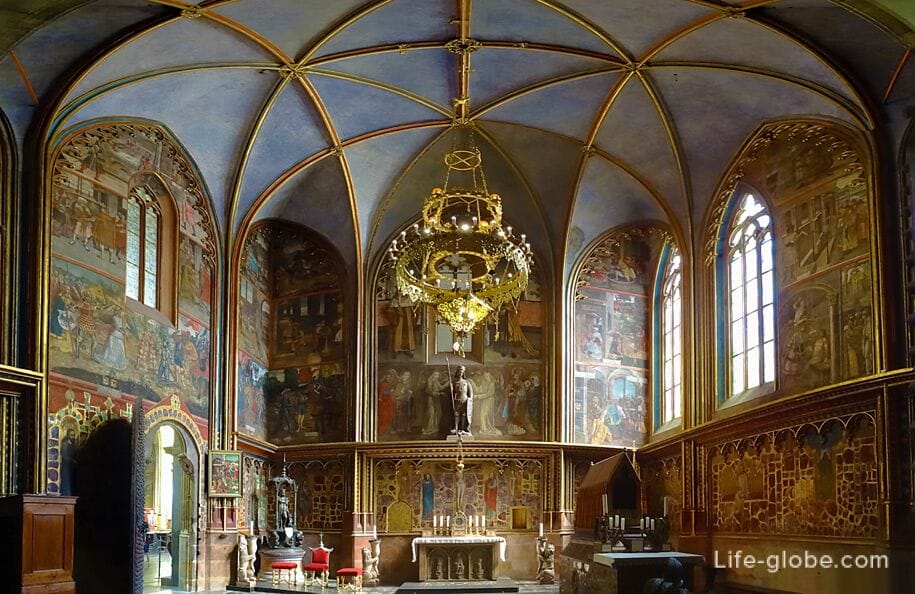

Among other rare structures in St. Vitus Cathedral, there are, at least, the marble tomb of Jan Ochek from Vlashim (1367-1370), six tombstones of the Przemyslovichs (after 1373), the silver tomb of Jan Nepomuksky (1733-1736) and the tomb of Count Leopold Schlick (1723), as well as a monument to Cardinal Bedrzych Schwarzenberg.
In the choir of the cathedral there are tombs: Brzetislav I, Spitikhnev II, Brzetislav II, Borivoy II (Czech princes), Przemysl Otakar I and Przemysl Otakar II (Czech kings).
In the center of the nave, in front of the main altar, there is a mausoleum (tomb) of Maximilian II, Ferdinand I and his wife Anna Jagiellonskaya, completed in 1589. The mausoleum is externally protected by a decorative lattice in the Renaissance style, on which the sides depict Czech kings and queens who are buried in an underground crypt-tomb, the entrance to which is from the Chapel of the Holy Cross (kaple sv. Kříže). The crypt contains the remains of Czech kings and emperors and their relatives: Rudolf I, Habsburg (King of Bohemia), Charles IV (King of Bohemia, Roman Emperor), Wenceslaus IV (King of Bohemia, Roman Emperor), Rudolf II (King of Bohemia, Roman Emperor), Ladislav Pogrobek (King of Bohemia and Hungary), George of Podebrad (King of Bohemia).
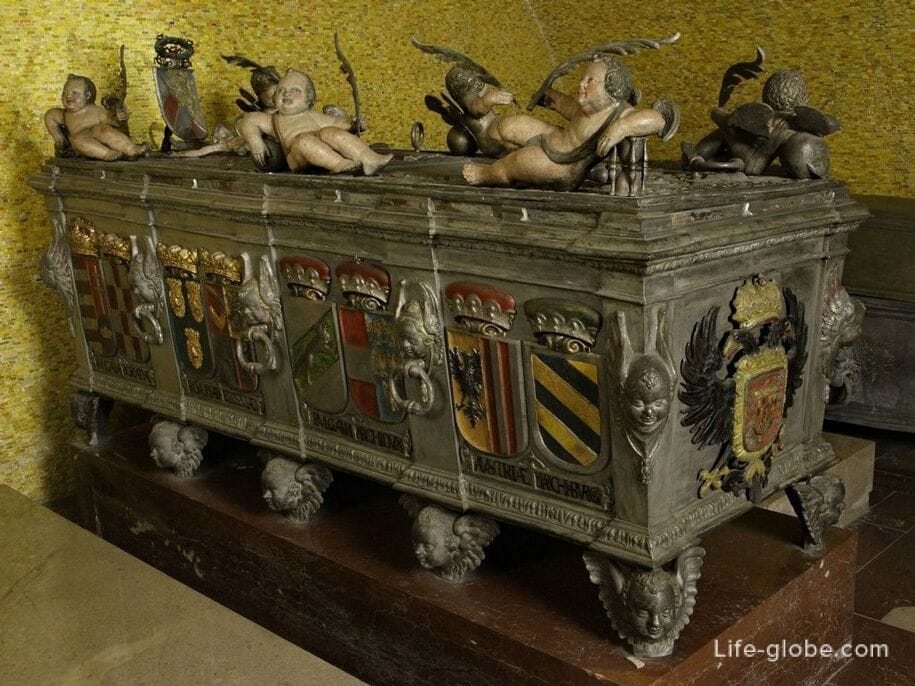
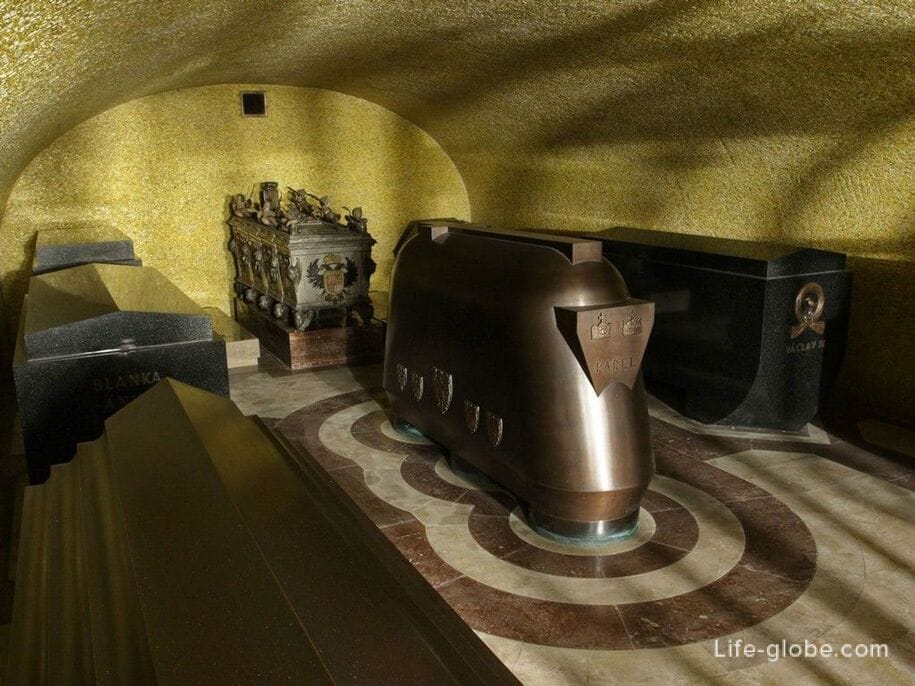
St. Vitus Cathedral has two buildings of organs.
The upper facade belonged to a Baroque organ created in 1765 by Anton Gartner, and the lower neoclassical building contains today's main organ. It was built by Josef Melzel in 1929-1931.
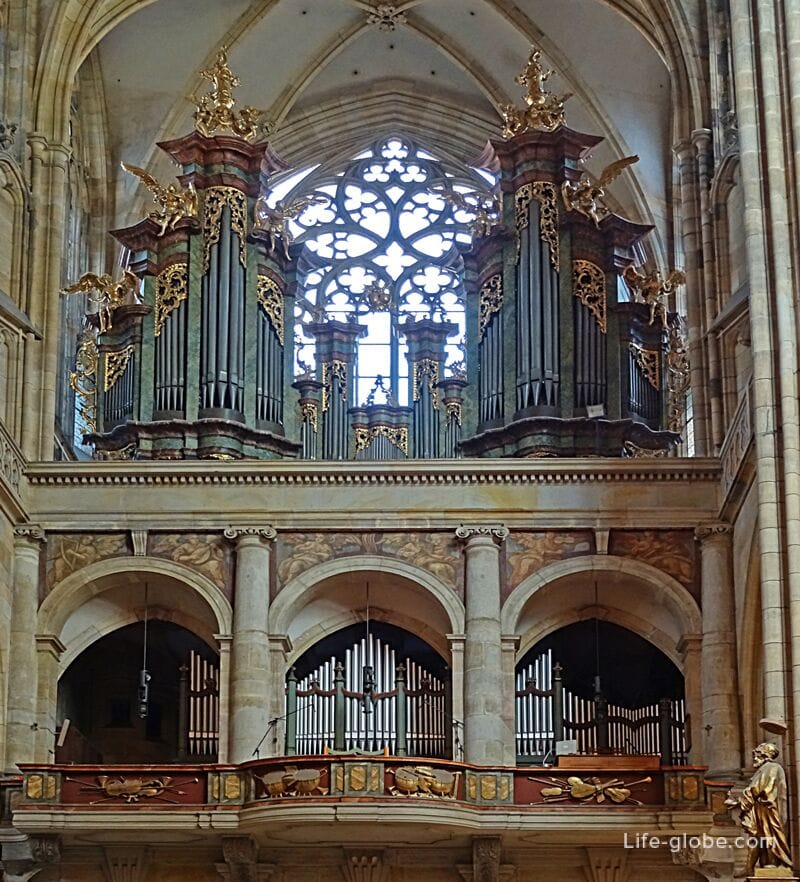
One of the most visited parts of St. Vitus Cathedral is the high Southern Church Tower (Velká jižní věž katedrály sv. Víta), having a height of almost 100 meters.
After passing 287 steps in the tower, you find yourself in the Renaissance gallery at a height of 56 meters, which is an observation deck and offers wonderful panoramic views of Prague.
During the ascent, you can see 7 bells, including the largest bell in the Czech Republic - Sigismund, dating from 1549.
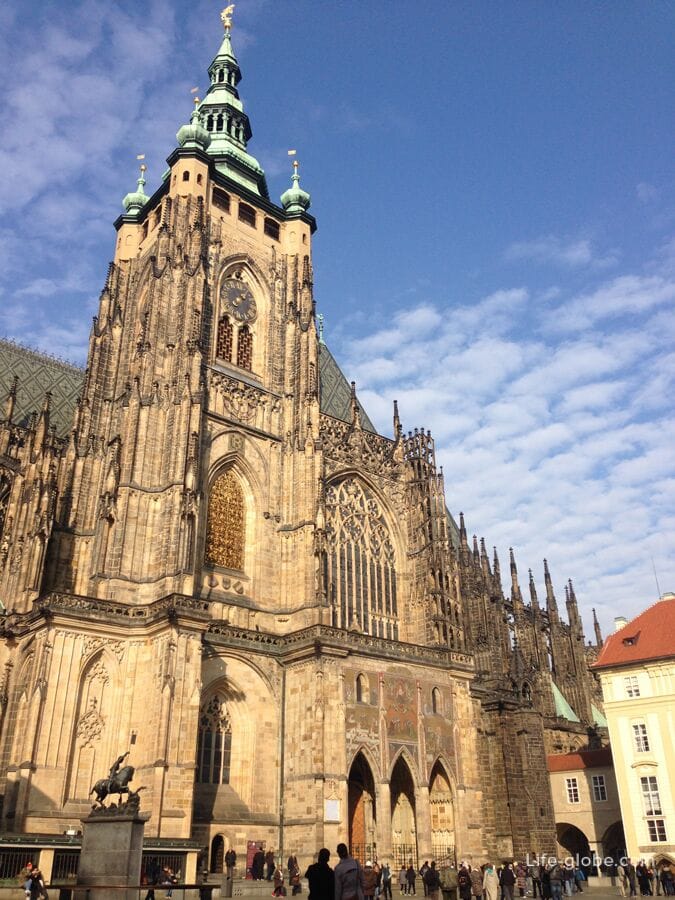


The Cathedral of St. Vitus hosts services and concerts of the cathedral choir.
You can visit the front neo-Gothic part of the cathedral for free. The historical part of the cathedral, including the Chapel of St. Wenceslaus and the tombs of the kings and princes of Przemysl, is available only if there is a valid tour of Prague Castle and for a fee, together with other objects of Prague Castle.
The crypt of the cathedral is inaccessible to visitors.
The ascent to the observation deck of the South Tower of the Cathedral is possible for a fee. The ascent to the tower is not included in the Prague Castle tour and is paid separately. Access to the observation tower is provided from the III courtyard of Prague Castle, to the left of the Golden Gate. In case of bad weather, the tower is closed.
Tickets for excursions and to the cathedral's observation tower can be purchased at the Prague Castle Information Center. Tickets to the observation tower can also be purchased on the ground floor of the tower itself.
All conditions for visiting St. Vitus Cathedral, excursions, climbing to the observation deck in the tower, places of purchase of tickets and the cost of tickets, we recommend you to check on the official website of the Cathedral of St. Vitus, Wenceslaus and Voytech:katedralasvatehovita.cz/cs.
The entrance to the Prague Castle is free.
You can get to Prague Castle by public transport, taxi, car or on foot from the historical center of Prague. Learn more about Prague Castle, its objects and museums...
Address of St. Vitus Cathedral: III. nádvoří 48/2, 119 01 Praha 1-Hradčany, Czech Republic.
Coordinates of St. Vitus Cathedral: 50°05'27.0"N 14°24'03.0"E (50.090833, 14.400833).
All accommodation facilities in Prague (hotels, apartments, guest houses, etc.), including in the historical center of the city and more remotely from it, can be viewed and booked here